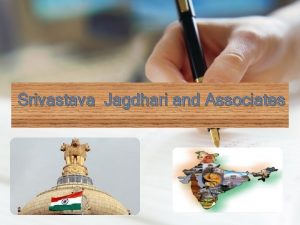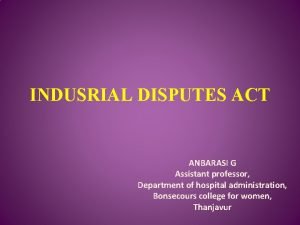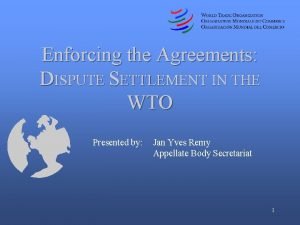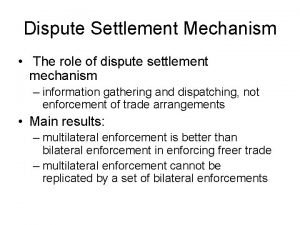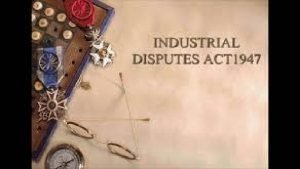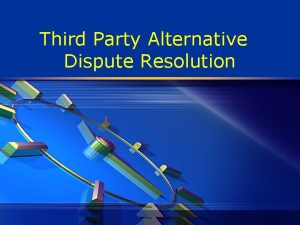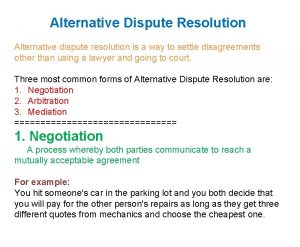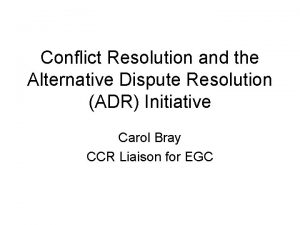Alternative Dispute Resolution ADR Training Session 01 Date
![Alternative Dispute Resolution [ADR] Training Session – 01 Date: ______ Welcome Alternative Dispute Resolution [ADR] Training Session – 01 Date: ______ Welcome](https://slidetodoc.com/presentation_image_h2/56a831f27474749bd06d27ee429eaf2f/image-1.jpg)

![common Types of ADR [a] Mediation [b] Arbitration [c] N [d] egotiation S ettlement common Types of ADR [a] Mediation [b] Arbitration [c] N [d] egotiation S ettlement](https://slidetodoc.com/presentation_image_h2/56a831f27474749bd06d27ee429eaf2f/image-3.jpg)







![Facilitator's Notes: [1] ADR Handbook [2] ADR Tool (courtesy of Cambodian Human Rights) [3] Facilitator's Notes: [1] ADR Handbook [2] ADR Tool (courtesy of Cambodian Human Rights) [3]](https://slidetodoc.com/presentation_image_h2/56a831f27474749bd06d27ee429eaf2f/image-11.jpg)
- Slides: 11
![Alternative Dispute Resolution ADR Training Session 01 Date Welcome Alternative Dispute Resolution [ADR] Training Session – 01 Date: ______ Welcome](https://slidetodoc.com/presentation_image_h2/56a831f27474749bd06d27ee429eaf2f/image-1.jpg)
Alternative Dispute Resolution [ADR] Training Session – 01 Date: ______ Welcome

![common Types of ADR a Mediation b Arbitration c N d egotiation S ettlement common Types of ADR [a] Mediation [b] Arbitration [c] N [d] egotiation S ettlement](https://slidetodoc.com/presentation_image_h2/56a831f27474749bd06d27ee429eaf2f/image-3.jpg)
common Types of ADR [a] Mediation [b] Arbitration [c] N [d] egotiation S ettlement Conferences

Mediation In mediation, an impartial person called a "mediator" helps the parties try to reach a mutually acceptable resolution of the dispute. The mediator does not decide the dispute but helps the parties communicate so they can try to settle the dispute themselves. Mediation leaves control of the outcome with the parties. Arbitration In arbitration, a neutral person called an "arbitrator" hears arguments and evidence from each side and then decides the outcome of the dispute. Arbitration is less formal than a trial, and the rules of evidence are often relaxed. Arbitration may be either "binding" or "nonbinding. " Binding arbitration means that the parties waive their right to a trial and agree to accept the arbitrator's decision as final. Generally, there is no right to appeal an arbitrator's decision. Nonbinding arbitration means that the parties are free to request a trial if they do not accept the arbitrator's decision. Neutral Evaluation In neutral evaluation, each party gets a chance to present the case to a neutral person called an "evaluator. " The evaluator then gives an opinion on the strengths and weaknesses of each party's evidence and arguments and about how the dispute could be resolved. The evaluator is often an expert in the subject matter of the dispute. Although the evaluator's opinion is not binding, the parties typically use it as a basis for trying to negotiate a resolution of the dispute. Settlement Conferences Settlement conferences may be either mandatory or voluntary. In both types of settlement conferences, the parties and their attorneys meet with a judge or a neutral person called a "settlement officer" to discuss possible settlement of their dispute. The judge or settlement officer does not make a decision in the case but assists the parties in evaluating the strengths and weaknesses of the case and in negotiating a settlement. Settlement conferences are appropriate in any case where settlement is an option. Mandatory settlement conferences are often held close to the date a case is set for trial.

Stages In ADR Processes • • • STAGE 1: MEETINGS 1. The roles of the mediator [note below] 2. Studying the details of the conflicts 3. How to invite conflict parties 3. 1 Invitation letter 3. 2 Contact via phone 3. 3 Face-to-face meeting 4. Lobbying the parties who are unwilling to participate in the mediation process 5. How to create a safe environment for parties to talk Mediator is used in a broader sense to refer to “neutral” in the various ADR types.

STAGE 2: TALKING 1. How to set basic rules 2. Encouraging parties to solve conflicts based on their interests 3. Leading the parties in the discussion 4. How to deal with emotions 5. Change of parties’ perceptions

STAGE 3: SHARING Introduction 1. Establishment of a concept of change 2. Explanation about legal and social consequences 3. How to overcome power imbalances between parties? 4. How to encourage parties to make offers?

STAGE 4: DECISION Introduction 1. How to obtain involvement from a third person? 2. How to ensure neutrality of the third person helping to reach a fair decision? 3. How to proceed the resolution process with a third person in a just and neutral manner? 4. How to establish a neutral decision-making forum?

STAGE 5: STABILIZE AND IMPLEMENT Introduction 1. Drafting of agreement 2. Documentation 3. Use of Witnesses 4. Starting the implementation of the agreement 5. Official agreement The End Thank You For Your Attention!!!!

ANNEXES Annex (A): Roles and rules of mediators Annex (B): Asking questions to collect information Annex (C): Short stories and proverbs Annex (D): Setting arrangements Annex (E): Method to select a third person Annex (F): Forms to be used Annex (G): Sample ADR Agreement Form
![Facilitators Notes 1 ADR Handbook 2 ADR Tool courtesy of Cambodian Human Rights 3 Facilitator's Notes: [1] ADR Handbook [2] ADR Tool (courtesy of Cambodian Human Rights) [3]](https://slidetodoc.com/presentation_image_h2/56a831f27474749bd06d27ee429eaf2f/image-11.jpg)
Facilitator's Notes: [1] ADR Handbook [2] ADR Tool (courtesy of Cambodian Human Rights) [3] The DON-ADR Program (US Navy) [4] ADR Practitioners' Guide
 Msc in construction law
Msc in construction law Dividend declaration date
Dividend declaration date Ex date for dividend
Ex date for dividend High resolution low resolution
High resolution low resolution Objectives of industrial dispute act 1947
Objectives of industrial dispute act 1947 Krishna godavari dispute
Krishna godavari dispute Objectives of industrial dispute act 1947
Objectives of industrial dispute act 1947 Wto dispute settlement mechanism
Wto dispute settlement mechanism Dispute settlement mechanism meaning
Dispute settlement mechanism meaning Rights dispute
Rights dispute Objectives of industrial dispute act 1947
Objectives of industrial dispute act 1947 Maine canada border dispute
Maine canada border dispute




